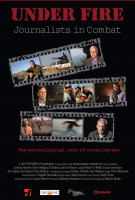Under Fire: Journalists in Combat Filming Locations

Where was Under Fire: Journalists in Combat filmed? Under Fire: Journalists in Combat was filmed in 11 locations across Canada, Afghanistan, Senegal, United Kingdom, United States and Libya in the following places:
Under Fire: Journalists in Combat Filming Locations
Toronto, the capital of the province of Ontario, is a major Canadian city along Lake Ontario’s northwestern shore. It's a dynamic metropolis with a core of soaring skyscrapers, all dwarfed by the iconic, free-standing CN Tower. Toronto also has many green spaces, from the orderly oval of Queen’s Park to 400-acre High Park and its trails, sports facilities and zoo.
Vancouver, a bustling west coast seaport in British Columbia, is among Canada’s densest, most ethnically diverse cities. A popular filming location, it’s surrounded by mountains, and also has thriving art, theatre and music scenes. Vancouver Art Gallery is known for its works by regional artists, while the Museum of Anthropology houses preeminent First Nations collections.
Afghanistan, officially the Islamic Emirate of Afghanistan, is a landlocked country located at the crossroads of Central Asia and South Asia.
Dakar is the capital of Senegal, in West Africa. It’s an Atlantic port on the Cap-Vert peninsula. Its traditional Médina quarter is home to the Grande Mosquée, marked by a towering minaret. The Musée Théodore Monod displays cultural artifacts including clothing, drums, carvings and tools. The city’s vibrant nightlife is inspired by the local mbalax music.
Devon is a county in southwest England. It encompasses sandy beaches, fossil cliffs, medieval towns and moorland national parks. The English Riviera is a series of picturesque, south-coast harbour towns including Torquay, Paignton and Brixham. The South West Coast Path follows the coastline, taking in the towering cliffs of the northern Exmoor Coast and rock formations on the fossil-rich southern Jurassic Coast.
England is a country that is part of the United Kingdom. It is located on the island of Great Britain, of which it covers approximately 62%, and over 100 smaller adjacent islands.
Fort Benning South is a former census-designated place in Chattahoochee County, Georgia, United States. It is part of the Columbus, Georgia-Alabama metropolitan statistical area. The population was 11,737 at last official census. The area is now part of consolidated Cusseta–Chattahoochee County.
London, the capital of England and the United Kingdom, is a 21st-century city with history stretching back to Roman times. At its centre stand the imposing Houses of Parliament, the iconic ‘Big Ben’ clock tower and Westminster Abbey, site of British monarch coronations. Across the Thames River, the London Eye observation wheel provides panoramic views of the South Bank cultural complex, and the entire city.
Washington, DC, the U.S. capital, is a compact city on the Potomac River, bordering the states of Maryland and Virginia. It’s defined by imposing neoclassical monuments and buildings – including the iconic ones that house the federal government’s 3 branches: the Capitol, White House and Supreme Court. It's also home to iconic museums and performing-arts venues such as the Kennedy Center.
Under Fire: Journalists in Combat (2011)
Journalism in times of war has become an increasingly lethal and traumatic endeavor for the men and women who face constant threats to their lives and psyches. With the death toll skyrocketing from only two reporters killed in World War I to almost a journalist a week being killed in the last two decades, UNDER FIRE weaves together portraits, battlefield accounts and combat footage to reveal what the reporters see, think and feel. Martyn Burke, documentary filmmaker whose work has brought him to battlefields around the world, and Anthony Feinstein, the psychiatrist who works with journalists to heal the trauma, delve into the experiences of top tier correspondents from AP, New York Times, BBC, and LA Times, among others, bringing a unique understanding and insight into the psychological cost of covering war.
